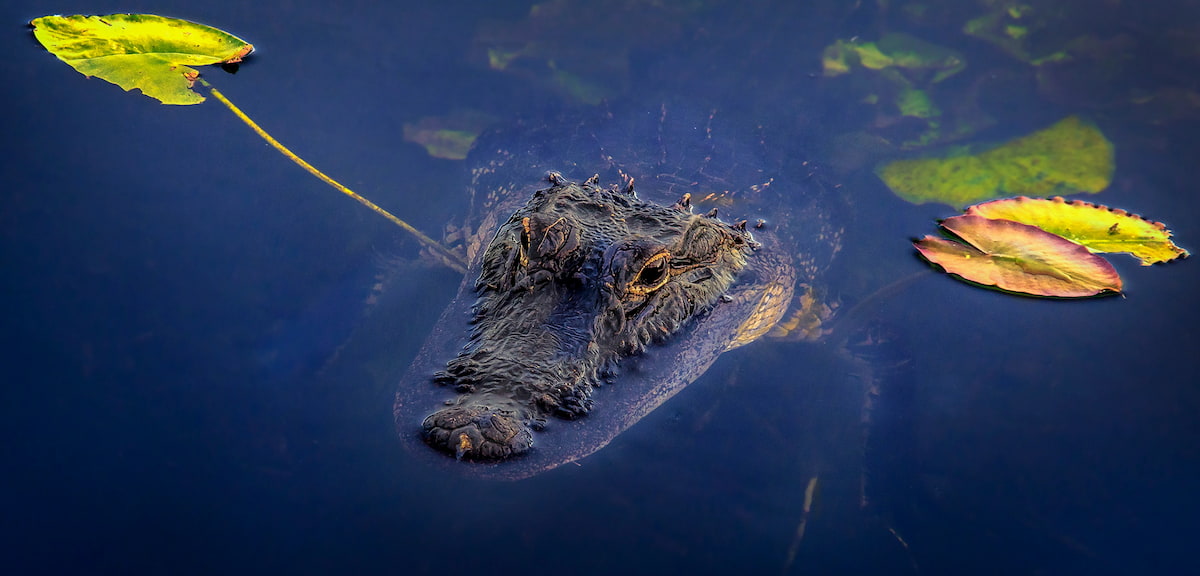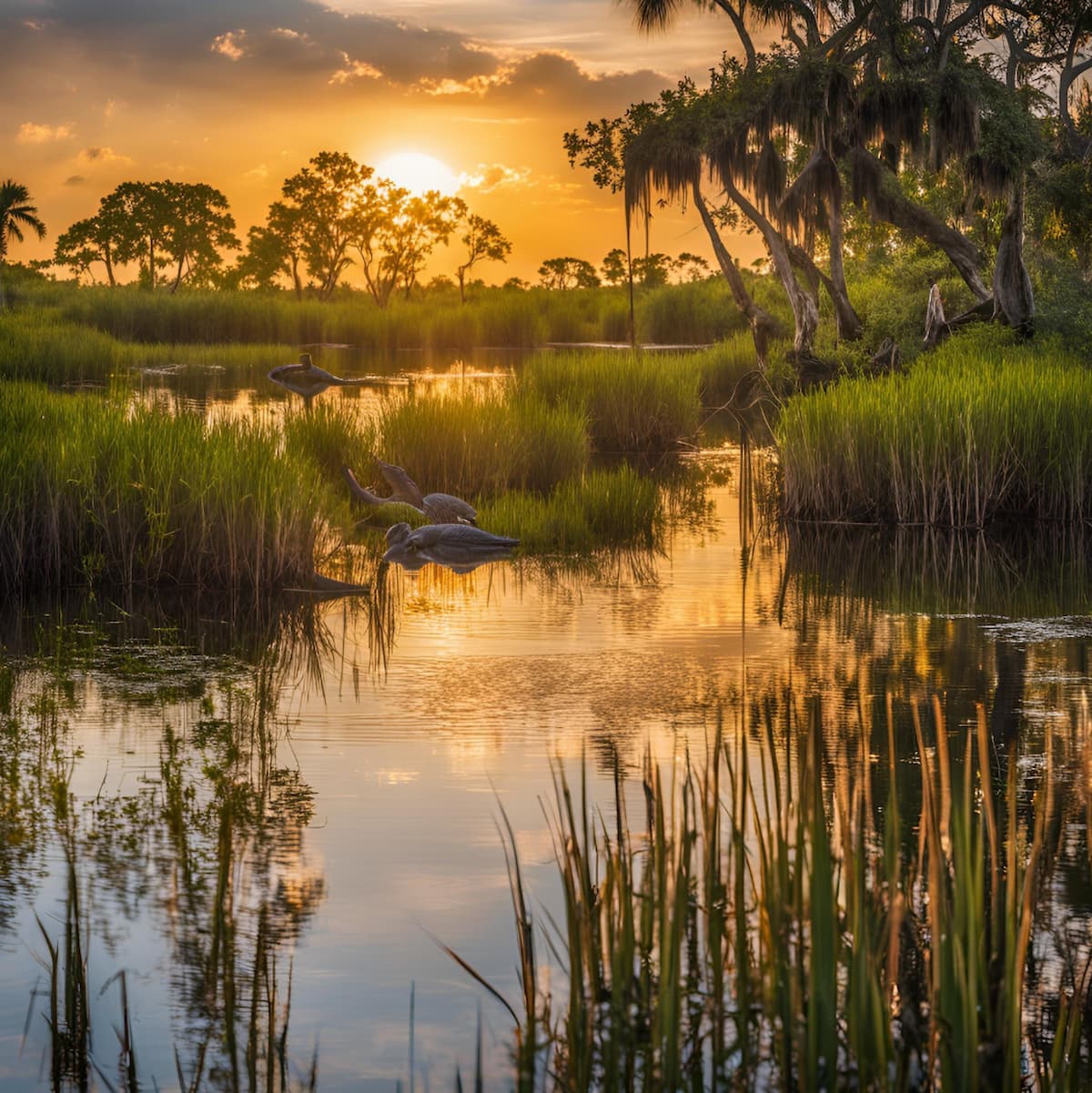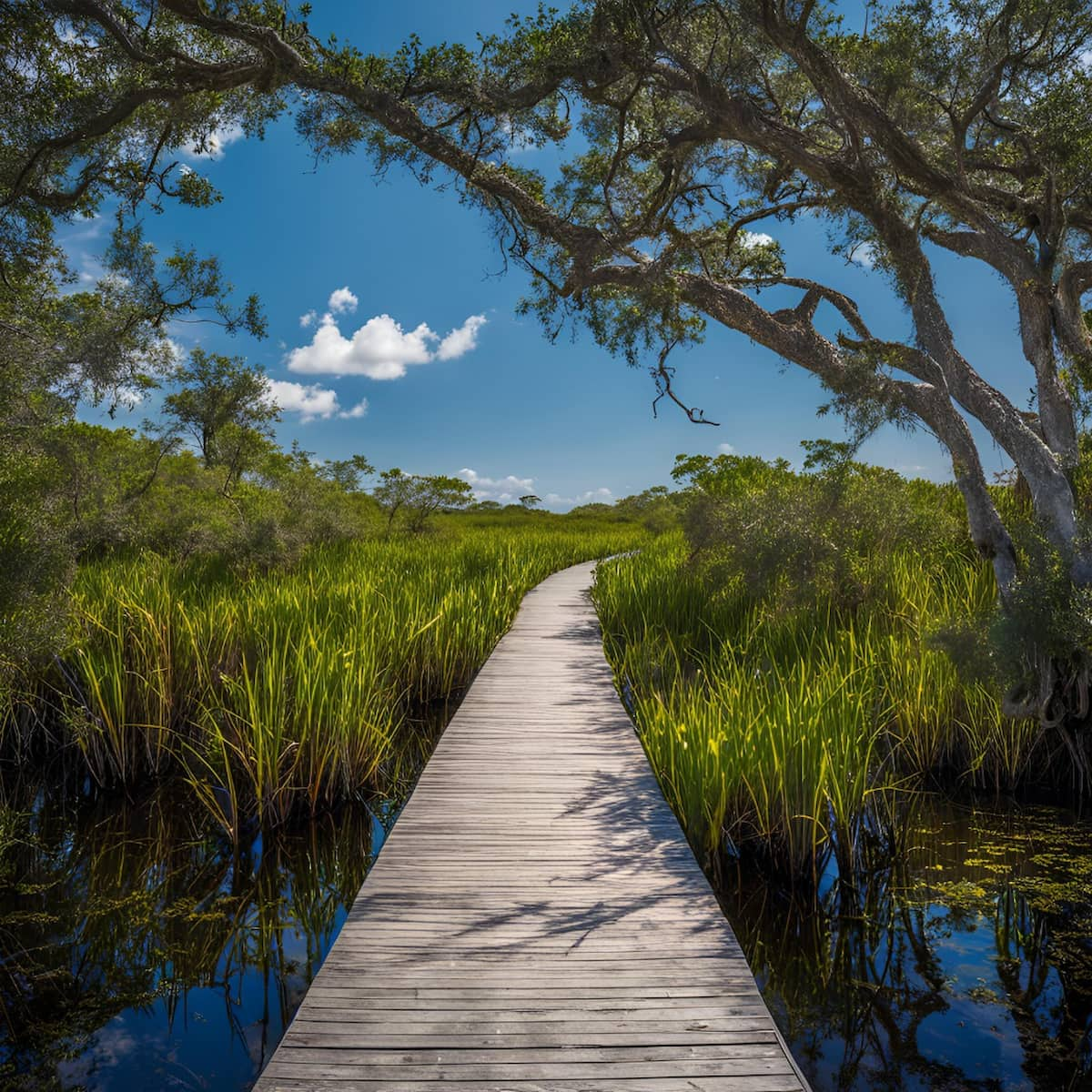
Watch short for this article (5 slides)
Everglades National Park: The Intricate World of the "River of Grass"
Stretching across the southern tip of Florida, Everglades National Park protects one of the planet's most unique and vital ecosystems – a vast, subtropical wilderness unlike anywhere else on Earth. Designated a UNESCO World Heritage Site, an International Biosphere Reserve, and a Wetland of International Importance (Ramsar site), the Everglades is far more than just a swamp. It's a complex, slow-moving "River of Grass," a mosaic of interconnected habitats teeming with specialized wildlife, including numerous threatened and endangered species. Understanding the Everglades requires looking beyond its surface beauty to appreciate its intricate hydrology, immense biodiversity, profound ecological importance, and the urgent threats it faces.

Photo by Sterling Lanier on Unsplash - The American alligator is an iconic resident and keystone species of the Everglades.
The Defining Feature: Understanding the "River of Grass"
The famous description "River of Grass," popularized by conservationist Marjory Stoneman Douglas in her seminal 1947 book, perfectly captures the essence of the Everglades' unique hydrology. It's not a conventional river with defined banks, but rather a vast, shallow sheet of water, often only inches deep but historically up to 60 miles (97 km) wide. This sheet flows almost imperceptibly southward from Lake Okeechobee towards Florida Bay, moving slowly across a nearly flat limestone bedrock base with a very gentle elevation gradient (dropping only about 2-3 inches per mile).
This slow, sheet-like flow creates a unique wetland system characterized by:
- Hydroperiod: The length of time an area is inundated with water during the year. Different plant communities are adapted to specific hydroperiods, ranging from constantly submerged areas to those only wet during the peak rainy season (summer).
- Water Quality: Historically, the water flowing south was exceptionally clean, low in nutrients like phosphorus.
- Seasonal Cycles: The ecosystem pulses with distinct wet (summer) and dry (winter) seasons, driving wildlife behavior like breeding cycles and migrations within the system.
This natural flow regime, however, has been dramatically altered over the past century by extensive drainage projects (canals, levees) built for agriculture and urban development, fundamentally changing the quantity, quality, timing, and distribution of water – the core challenge the ecosystem faces today.
A Mosaic of Habitats: Diverse Everglades Ecosystems
Everglades National Park protects a variety of interconnected ecosystems, each supporting specialized flora and fauna:
- Sawgrass Marshes (Freshwater Slough): The dominant landscape, defining the "River of Grass." Vast prairies dominated by sharp-edged sawgrass (Cladium jamaicense), thriving in areas with longer hydroperiods. Scattered within are slightly elevated "tree islands."
- Tree Islands (Hardwood Hammocks and Bayheads): Dense clusters of trees growing on slight elevations within the sawgrass marsh, often just inches higher than the surrounding water level. Hardwood hammocks feature tropical hardwood trees (gumbo limbo, mahogany) on higher ground, while bayheads occupy slightly lower, wetter areas. They provide crucial dry ground, shelter, and nesting sites for terrestrial animals like deer, raccoons, bobcats, and the Florida panther.
- Cypress Domes and Strands: Areas dominated by cypress trees. Domes are roughly circular clusters growing in shallow depressions, often with taller trees in the center. Strands are elongated forested wetlands following slight depressions in the bedrock.
- Pine Rocklands: Found on slightly higher limestone ridges, these unique forests feature slash pine canopy over an understory rich in endemic subtropical plants. They are fire-dependent ecosystems.
- Mangrove Estuaries: Along the coast where freshwater meets saltwater, extensive mangrove forests dominate. Red, black, and white mangroves, adapted to saline conditions and waterlogged soils, form intricate coastal ecosystems. They provide critical nursery habitat for fish and shellfish, stabilize shorelines, and protect inland areas from storm surges.
- Florida Bay: A vast, shallow marine estuary at the southern tip of the park, characterized by seagrass beds, mangrove islands (keys), and mudflats. It's a vital nursery for shrimp, lobster, and numerous fish species, and feeding grounds for wading birds and crocodiles. Its health is directly linked to the quantity and quality of freshwater flowing from the upstream Everglades. (Source: NPS - Everglades Ecosystems)
Biodiversity Under Pressure: Wildlife of the Everglades
The Everglades' unique position at the confluence of temperate and subtropical climates, combined with its diverse wetland, freshwater, and marine habitats, supports an incredible array of life. However, many species are threatened or endangered due to habitat loss and altered hydrology.
- American Alligator: The iconic reptile and a keystone species. Alligators create "gator holes" by digging out depressions that retain water during the dry season. These holes become vital refuges for fish, turtles, birds, and other wildlife, concentrating prey and providing essential water sources that sustain the ecosystem through dry periods.
- American Crocodile: Rarer and more secretive than the alligator, the crocodile inhabits the brackish and saltwater environments of South Florida, including Florida Bay within the park. The Everglades is unique as the only place globally where alligators and crocodiles naturally coexist.
- Wading Birds: Once present in astonishing numbers, populations of wading birds like the Roseate Spoonbill (with its distinctive pink plumage and spatulate bill), Great Egret, Snowy Egret, Wood Stork (an indicator species whose nesting success reflects ecosystem health), White Ibis, and various herons depend on the seasonal cycle of wet and dry periods to concentrate their prey (fish, invertebrates) in shallow pools for effective feeding, especially during nesting season. Altered water flows have significantly impacted their populations.
- Florida Panther: The state animal, this critically endangered subspecies of puma requires vast territories. While elusive, the park provides crucial habitat. Vehicle collisions and habitat fragmentation outside park boundaries are major threats.
- West Indian Manatee: These gentle marine mammals frequent the park's coastal waters and estuaries, feeding on seagrass. They are vulnerable to boat strikes and habitat degradation.
- Other Notable Wildlife: Bottlenose dolphins, sea turtles (nesting on coastal beaches), river otters, bobcats, white-tailed deer, numerous fish species (both freshwater and saltwater), amphibians, and reptiles are part of the park's rich fauna.

The elusive Florida panther relies on the vast wilderness of the Everglades.
An Ecosystem Imperiled: Major Threats
The Everglades ecosystem is critically endangered, facing a barrage of interconnected threats:
- Altered Hydrology (The Core Problem): Decades of constructing canals, levees, and water control structures for flood control and water supply for South Florida's agriculture and urban areas have drastically reduced the *quantity* of water flowing into the park (estimated at only about half the historic flow), disrupted the *timing* and *distribution* of water (preventing natural sheet flow and causing parts to be too wet or too dry at the wrong times), and fundamentally fragmented the ecosystem.
- Water Quality Degradation: Runoff from agricultural areas north of the park carries high levels of nutrients, particularly phosphorus. This nutrient pollution fuels the growth of dense cattail stands that choke out native sawgrass prairies and disrupts the base of the food web adapted to low-nutrient conditions. Mercury contamination, bioaccumulating in the food chain, also poses a risk.
- Invasive Species: The subtropical climate allows numerous non-native species to thrive, often outcompeting native wildlife.
- Burmese Pythons: These giant constrictors, established likely through the pet trade, have decimated populations of mid-sized mammals (raccoons, opossums, marsh rabbits, bobcats) in the southern Everglades, causing severe ecological disruption.
- Exotic Plants: Species like Melaleuca (Australian paperbark tree), Brazilian Pepper, and Old World Climbing Fern aggressively invade native habitats, altering fire regimes, hydrology, and displacing native vegetation.
- Habitat Loss and Fragmentation: Continued urban and agricultural development along the park's boundaries reduces overall habitat area and fragments corridors essential for wide-ranging species like the Florida panther.
- Climate Change and Sea Level Rise: Poses an existential threat, particularly to coastal ecosystems. Rising sea levels drive saltwater intrusion further inland, contaminating freshwater marshes and aquifers crucial for both ecosystems and human water supply. Mangrove forests are migrating inland, displacing freshwater habitats. Increased hurricane intensity also threatens coastal areas.
Restoring the Flow: The Comprehensive Everglades Restoration Plan (CERP)
Recognizing the dire situation, the US Congress authorized CERP in 2000. This massive, multi-decade, multi-billion dollar federal-state partnership represents one of the most ambitious ecosystem restoration projects ever undertaken globally.
CERP aims to "get the water right" by restoring more natural patterns of water quantity, quality, timing, and distribution. Key components involve:
- Removing barriers to sheet flow (e.g., portions of the Tamiami Trail roadbed have been elevated onto bridges).
- Creating large water storage areas (reservoirs and underground storage) to capture excess water during wet periods and release it more naturally during dry periods.
- Building vast engineered wetlands (Stormwater Treatment Areas - STAs) to filter phosphorus and other pollutants from water before it enters the Everglades.
- Modifying operations of existing canals and levees to better mimic natural flows.
Progress is being made, but CERP faces immense technical, political, and funding challenges. Its success is crucial for the long-term survival of the Everglades ecosystem and the water supply for millions of Floridians. (Source: EvergladesRestoration.gov - Official CERP site)
Exploring the River of Grass: Visitor Experiences
Everglades National Park offers unique ways to experience its subtle beauty and diverse wildlife:
- Visitor Centers: Main entrances include the Ernest F. Coe Visitor Center (near Homestead/Florida City), Shark Valley Visitor Center (along Tamiami Trail), and Gulf Coast Visitor Center (Everglades City). Each offers information, exhibits, and access to different park areas.
- Wildlife Viewing Trails:
- Anhinga Trail (Royal Palm area): A short, paved boardwalk trail renowned for close-up views of alligators, turtles, fish, and numerous wading birds like anhingas ("snake birds"), herons, and egrets.
- Shark Valley Tram Road: A 15-mile paved loop accessible via tram tours or bicycle rentals, leading to an observation tower with panoramic views over the sawgrass prairie. Excellent for spotting alligators and birds.
- Boating:
- Canoeing/Kayaking: Numerous marked canoe trails wind through mangroves (e.g., Nine Mile Pond Canoe Trail, Hell's Bay Canoe Trail) and freshwater marshes. The 99-mile Wilderness Waterway offers a challenging backcountry paddling experience.
- Motorboating: Primarily in Florida Bay and coastal areas; regulations apply regarding speed and access to protect seagrass and wildlife.
- Airboat Tours: While iconic for Everglades exploration, commercial airboat tours operate primarily *outside* the official boundaries of Everglades National Park, typically run by private operators or within the Miccosukee Indian Reservation along Tamiami Trail.
- Ranger Programs: Guided walks, talks, canoe trips, and educational programs offer valuable insights into the park's ecology and history.

Airboat tours offer a popular way to experience the Everglades, typically outside national park boundaries.
Visitor Preparedness: Visiting requires preparation for heat, humidity, intense sun, and abundant insects (mosquitoes, biting flies). Bring water, sunscreen, insect repellent, and wear appropriate clothing. Be aware of wildlife and maintain safe distances.
Conclusion: A Global Treasure at a Crossroads
Everglades National Park protects a globally unique wetland ecosystem, a "River of Grass" whose subtle beauty belies its ecological complexity and critical importance. It is a sanctuary for remarkable biodiversity, a vital source of freshwater for South Florida, and a natural buffer against storms. Yet, this fragile paradise stands at a critical crossroads, severely impacted by altered hydrology, pollution, invasive species, and the escalating threat of climate change. The ambitious efforts underway through CERP offer hope, but the future of the Everglades hinges on sustained commitment to restoration and addressing the underlying environmental pressures. Visiting the Everglades offers not just a chance to see alligators and stunning birds, but an opportunity to witness firsthand the delicate balance of a vital ecosystem striving for survival – a poignant reminder of our profound connection to, and responsibility for, the natural world.